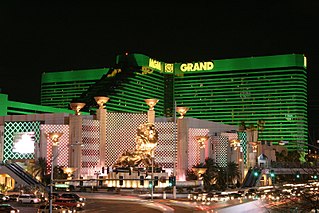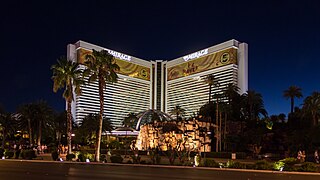
The Westgate Las Vegas Resort & Casino is a hotel, casino, and timeshare resort in Winchester, Nevada. Located near the northern end of the Las Vegas Strip, it is owned by Westgate Resorts. It opened in 1969 as the International Hotel, and was known for many years as the Las Vegas Hilton, then briefly as the LVH – Las Vegas Hotel and Casino. From 1981 to 1990, it was the largest hotel in the world.

MGM Resorts International is an American global hospitality and entertainment company operating destination resorts in Las Vegas, Massachusetts, Michigan, Mississippi, Maryland, Ohio, and New Jersey, including Bellagio, Mandalay Bay, MGM Grand, and Park MGM.
Mirage Resorts was an American company that owned and operated hotel-casinos. It was acquired by MGM Grand, Inc. in 2000, forming MGM Mirage.

The Las Vegas Strip is a stretch of Las Vegas Boulevard in Clark County, Nevada, that is known for its concentration of resort hotels and casinos. The Strip, as it is known, is about 4.2 mi (6.8 km) long, and is immediately south of the Las Vegas city limits in the unincorporated towns of Paradise and Winchester, but is often referred to simply as "Las Vegas".

Kerkor "Kirk" Kerkorian was an Armenian-American businessman, investor, and philanthropist. He was the president and CEO of Tracinda Corporation, his private holding company based in Beverly Hills, California. Kerkorian was one of the important figures in the shaping of Las Vegas and, with architect Martin Stern Jr., is described as the "father of the mega-resort". He built the world's largest hotel in Las Vegas three times: the International Hotel, the original MGM Grand Hotel (1973) and the current MGM Grand (1993). He purchased the Metro-Goldwyn-Mayer movie studio in 1969.

Bellagio is a resort, luxury hotel and casino on the Las Vegas Strip in Paradise, Nevada. It is owned by Blackstone Inc. and operated by MGM Resorts International. Bellagio was conceived by casino owner Steve Wynn, and was built on the former site of the Dunes hotel-casino. Wynn's company, Mirage Resorts, purchased the Dunes in 1992. Plans were announced in 1994 to replace it with Beau Rivage, a French-themed resort. However, Wynn changed the project plans in 1995, instead theming it after the village of Bellagio, near Lake Como. The resort was designed by Jon Jerde. Construction began on November 1, 1995, with Marnell Corrao Associates as general contractor.

Treasure Island Hotel and Casino is a pirate-themed hotel and casino located on the Las Vegas Strip in Paradise, Nevada, U.S. It includes 2,885 rooms and a 47,927 sq ft (4,452.6 m2) casino. The resort is owned and operated by businessman Phil Ruffin.

The MGM Grand Las Vegas is a hotel and casino located on the Las Vegas Strip in Paradise, Nevada. It is owned by Vici Properties and operated by MGM Resorts International. The resort was developed by Kirk Kerkorian through his company, MGM Grand, Inc. Kerkorian had previously developed another MGM Grand, opened on the Strip in 1973 and renamed Bally's in 1986.

New York-New York Hotel and Casino is a casino hotel on the Las Vegas Strip in Paradise, Nevada, United States. It is owned by Vici Properties and operated by MGM Resorts International, and is designed to evoke New York City in its architecture and other aspects. The design features downsized replicas of numerous city landmarks such as the Statue of Liberty. The hotel tower represents various skyscrapers. Its tallest structure is a replica of the Empire State Building, standing at 47 stories and 529 feet (161 m). This made New York-New York the tallest building in Nevada until the completion of Wynn Las Vegas in 2005. The property includes the Big Apple Coaster, which travels around the hotel tower. The casino is 51,765 sq ft (4,809.1 m2), and the hotel contains 2,024 rooms.

The Boardwalk Hotel and Casino was a Coney Island-style hotel on the Las Vegas Strip. The property began in 1966, as a Holiday Inn. Norbert Jansen added a gift shop to the hotel in 1972, and later opened the Slot Joynt casino. In 1985, Jansen renamed the Holiday Inn as the Viscount Hotel, part of a U.S. chain. Four years later, he merged Slot Joynt with the Viscount and renamed them as the Boardwalk. It rejoined the Holiday Inn chain in 1994, through a franchise deal which eventually ended in 2002.

Park MGM, formerly Monte Carlo Resort and Casino, is a megaresort hotel and casino on the Las Vegas Strip in Paradise, Nevada, United States. It is owned by Vici Properties and operated by MGM Resorts International. It was developed by Mirage Resorts and Circus Circus Enterprises, both later acquired by MGM.

The Mirage is a casino resort on the Las Vegas Strip in Paradise, Nevada, United States. It is owned by Vici Properties and operated by Hard Rock International. The 65-acre property includes a 90,548 sq ft (8,412.2 m2) casino and 3,044 rooms.

Horseshoe Las Vegas is a casino hotel on the Las Vegas Strip in Paradise, Nevada. It is owned and operated by Caesars Entertainment. It originally opened as the MGM Grand Hotel and Casino on December 4, 1973. The 26-story hotel contained 2,100 rooms and was among the world's largest hotels.

Golden Nugget Hotels & Casinos is an American chain of luxury hotels and casinos. It currently operates six casino resorts in Nevada, Louisiana, New Jersey, Illinois, and Mississippi.

Aria Campus, commonly known by its former name CityCenter, is a mixed-use, urban complex on the Las Vegas Strip in Paradise, Nevada. It is located on 67 acres (27 ha) and contains a total of 18-million sq ft (1,700,000 m2). The complex includes Aria Resort and Casino, the Vdara condo-hotel, the Waldorf Astoria Las Vegas hotel and condominiums, the Veer Towers condominiums, and a mall known as The Shops at Crystals. Another hotel and condo project, The Harmon, never opened due to construction defects; the site was redeveloped as another shopping mall, known as 63.

The Signature at MGM Grand is a condo-hotel at the MGM Grand resort in Paradise, Nevada, near the Las Vegas Strip. It consists of three towers, each 38 stories in height, with a total of 1,728 units. MGM Mirage and Turnberry Associates partnered to develop the project, which was announced in 2002. Construction was underway in 2004, and the first tower opened in May 2006. The project was built on land previously used by the MGM Grand Adventures Theme Park.

MGM Grand Adventures was a theme park adjacent to the MGM Grand, a hotel and casino located on the Las Vegas Strip in Paradise, Nevada, United States. The theme park and resort were both developed by MGM Grand, Inc. Construction began in October 1991, and both projects opened on December 18, 1993. MGM Grand Adventures originally occupied 33 acres (13 ha), located northeast of the MGM Grand. The park featured a movie studio theme. It included seven rides and four theaters offering various shows.
Martin Stern Jr. was an American architect who was most widely known for his large scale designs and structures in Las Vegas, Nevada. He is credited with originating the concept of the structurally integrated casino resort complex in Las Vegas.
The LV Strip is one of the designated Nevada Gaming Control Boards reporting areas. It consists of the Las Vegas Strip casinos and many of the surrounding casinos. The Strip earns roughly 50% of the gaming revenue from all sources for the state of Nevada.
The Gaming Hall of Fame was established in 1989 to recognize individuals who have played a significant role in the gaming-entertainment industry.























